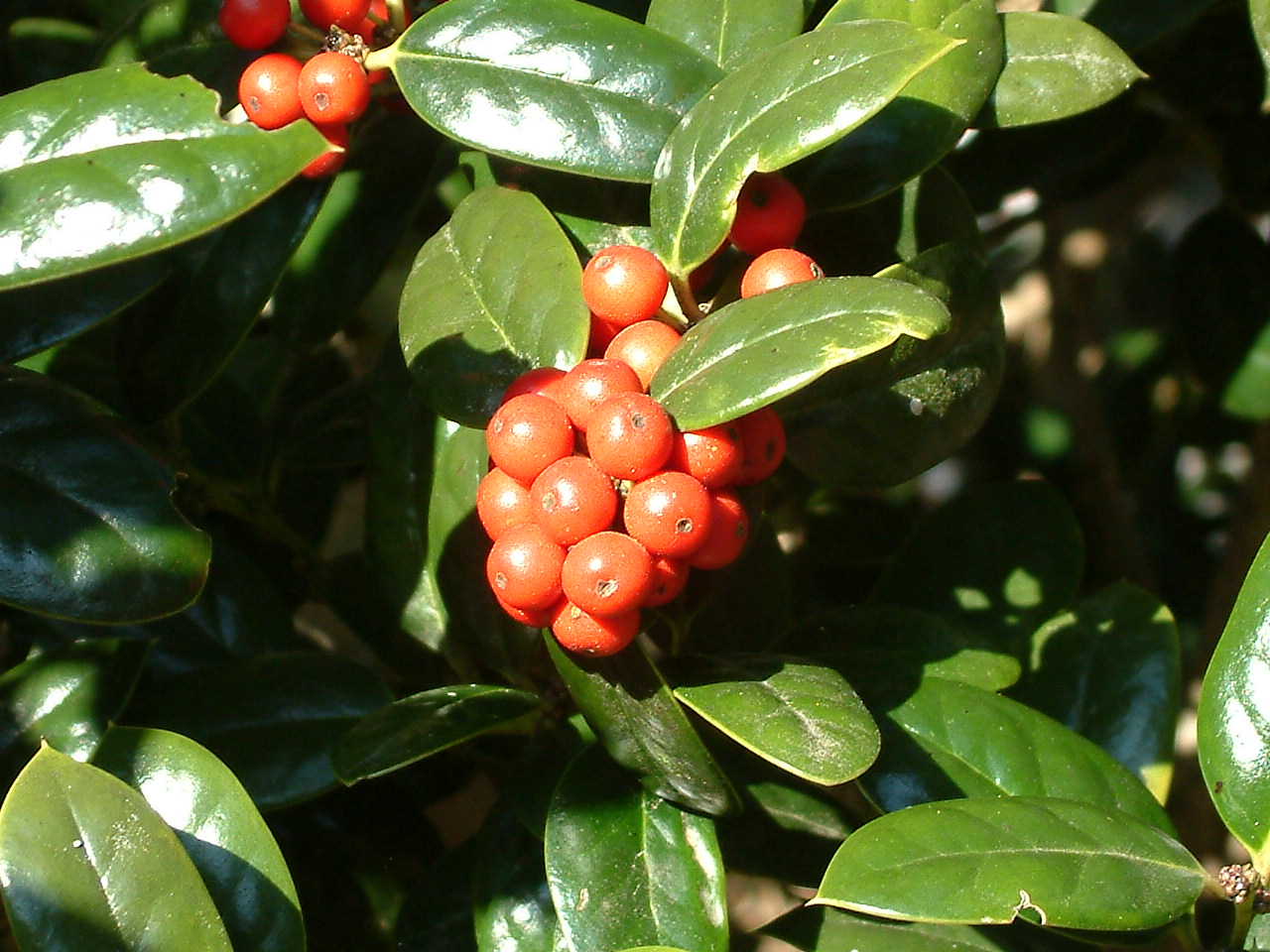
by Beth Bolles | Feb 18, 2014
Looking for a new shrub or small tree this year? Interested in one that is low maintenance and offers beautiful green color? Why not try a holly.
Hollies can be found in landscapes throughout North Florida. Many times these plants are used in foundation plantings around homes. They can help make the transition from the hard lines of a home to other parts of the yard. In other landscapes, hollies make an excellent screen, dividing property or blocking a view.
Because hollies are commonplace, they may be overlooked by homeowners who want to add an attractive new plant to the landscape. Hollies have many uses and there are new selections entering the market worth considering.
In general hollies will not need a great amount of maintenance. Once established most species will require only occasional water, fertilizer, and pruning. Many hollies have even grown well under neglected conditions. If you are one that keeps holly plants pruned as hedges, you will need to watch for the scale insect and spray plants with a horticultural oil every year.
When selecting a holly plant, it is good to know a little about the area where you want to place the plant. Hollies vary in size and ability to tolerate wet soil, so it is important to match a species with your specific site. Also consider holly leaf shapes when using the plants in areas where people walk. Some holly leaves are very stiff and sharp and could injury visitors to you home or be a nuisance when you are working in the yard.
If you are interested in the added beauty of holly berries during the year, remember to select a female plant.
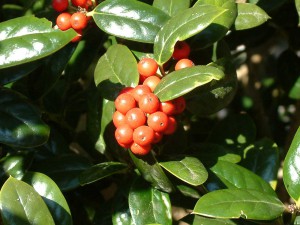
Hollies also attract bees to the landscape.
Credit: Beth Bolles, UF IFAS Extension Escambia County
Tree form hollies that you may select include the American holly (Ilex opaca), Savannah holly (Ilex x attenuata ‘Savannah’), and the Burford holly (Ilex cornuta ‘Burfordii’). All three plants will need well-drained soil. The American and Savannah holly will both reach heights between 20 and 40 feet and have a pyramidal growth form. The Savannah holly leaves will be a lighter green color than the leaves of other holly species. Burford holly has thick dark green leaves and grows about 12-15 feet in height over time.
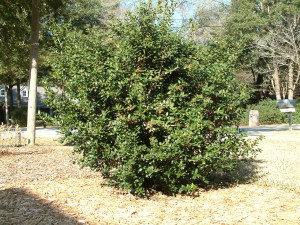
Burford holly is a beautiful holly that gives birds a place to hide.
Credit: Beth Bolles, UF IFAS Extension Escambia County
If you have a wet site, consider the Dahoon holly which can be a specimen plant or used as a screen. This plant will develop attractive grayish bark and grow about 20 feet in height with more of a spread than the previously mentioned hollies.
There are medium-sized hollies that make excellent specimen plants about 12 feet in height. ‘Festive’ holly has dark green foliage and forms dense growth in a pyramidal form. The ‘Robin’ holly has a similar growth form but displays beautiful reddish new growth. Both of these plants will need well-drained soil and full sun or partial shade.
For those areas that require smaller evergreen plants, consider a ‘Bordeaux’ yaupon holly. These plants will grow about 4 feet in height and spread and form a dense growth of stiff stems with small leathery leaves. Since these plants keep a naturally round form it is not necessary to shear them. Both hollies will tolerate a wide range of soil conditions and require little maintenance once established.
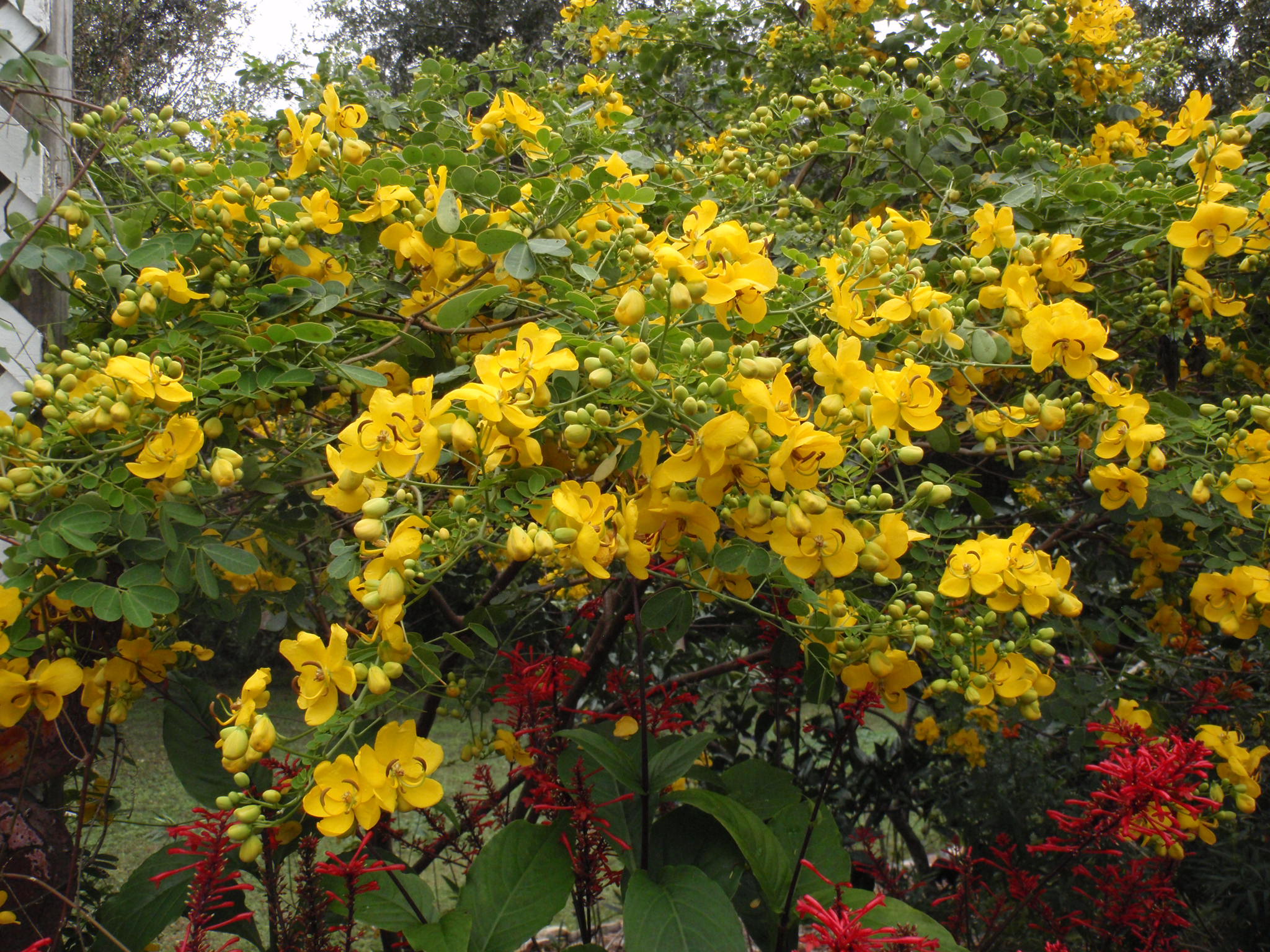
by Beth Bolles | Jan 14, 2014
Trees and shrubs often serve a distinct purpose in landscapes, other than to provide color. They are planted to provide shade, screen a view or noise, or to soften the hardscapes of the home.
With a little planning, we can have both beauty and function from trees and shrubs. Add a few trees and shrubs that have color in different seasons and your landscape will always be interesting.
The added benefit of growing trees and shrubs is that they are low maintenance. Once the plants are established in the landscape, they will require very little water and only an occasional application of a slow release fertilizer. A good layer of an organic mulch around the plants will help conserve moisture, prevent weeds, and keep root temperatures regulated during our temperature extremes. You may have to do a little pruning every year to remove any diseased, damaged, or severely crossing branches.
Here is a list of plants to give you garden interest throughout all seasons:
Winter color
- Taiwan cherry (Prunus campanulata) is an underutilized ornamental cherry for the coastal south. Clusters of dark pink flowers cover the plant which grows about 20 feet.
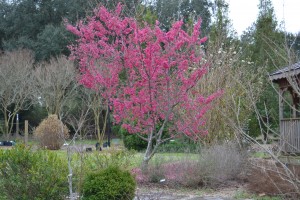
Taiwan cherry
- Camellia japonica is widely used in landscapes, but still an excellent choice for winter color. Careful selection of types will provide a garden with color from November through April.
- Red maple (Acer rubrum) will provide color in both the late winter and fall. Flowers are brilliant red in late winter and leaves begin turning red in late October.
- Other choices include Oakleaf hydrangea, Florida anise, Red buckeye, and Japanese magnolia
Spring
- Fringe tree (Chionanthus virginicus) can be in shrub or tree form and range in height from 10 – 20 feet. Forms white clusters of showy fringe-like flowers in late winter and early spring before the leaves emerge.
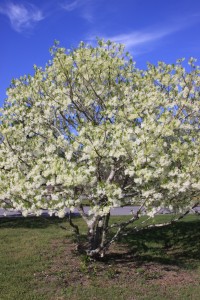
Fringe tree
- Chinese fringe (Lorepetalum chinesis ‘Rubrum’) is a very popular shrub. Pink blooms are heaviest in the spring. The plants can get up to 12 feet in height so plant it were it will not obstruct a view.
- Virginia sweetspire (Itea virginica) forms clusters of white flowers. Plants offer purplish foliage in the fall.
- Other choices include Banana shrub, native azaleas, Indian hawthorn, and Deutizia,
Summer
- Chaste tree (Vitex agnus castus) is a large shrub with fragrant leaves and spikes of purple flowers. Tolerates drought and develops interesting shape.
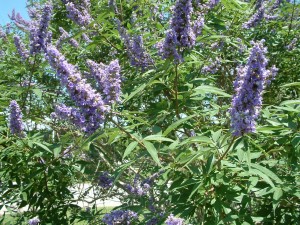
Chaste tree
- Loblolly bay (Gordonia lasianthus) is an evergreen tree that grows to 25-35 ft in height. Large white flowers with yellow stamens resemble camellia blooms.
- Abelia spp has white flowers that appear over the entire plant. It is attractive to butterflies .
- Other choices include Crape myrtle, Althea, Confederate rose, and Oleander
Fall
- Bald cypress (Taxodium distichum) will become a large tree over time. In the fall the feathery leaves will turn orange-brown. Good tree for both wet and dry areas.
- Beautyberry (Callicarpa americana) a native that forms clusters of purple berries that line the stem. Leaves turn yellow and provide fall interest as well.
- Cassia bicapsularis can reach 8-12 ft in height and will have bright yellow flowers that form in October and persist until a freeze.
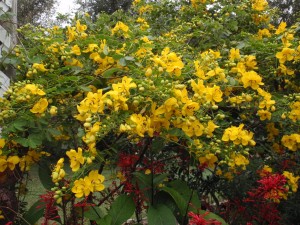
Cassia
by Beth Bolles | Dec 24, 2013

For best root development, thin carrots to 2-3 inches between each plant.
Many common cool season vegetable garden plants are started in raised beds by direct planting of seeds. It is important to follow the guidelines in the ‘Monthly Vegetable Planting Guide’ (Page 6) for plant spacing and seed depth. It is possible to thin out seedlings that are growing too close, but seeds that are planted at the incorrect depth may not germinate.
Vegetable seedlings will need to be thinned out after germination to allow for adequate space for leaf or root development. Crowded vegetables will compete with each other for water, nutrients, and sunlight and never produce quality plants.
Here are some tips for thinning seedlings:
- When plants are about 1 to 2 inches tall or have two sets of ‘true leaves’, it is time to thin out any crowded plants.
- Look up the proper spacing between plants and thin out appropriately.
- Pull out seedlings with fingers or forceps to make space or use small
scissors to cut off seedlings at the ground level.
- It will initially look like there is lots of room between seedlings but realize plants will grow quickly to utilize all available space.
by Beth Bolles | Nov 11, 2013
Fall color in the Florida landscape may be a little different than more northern areas but it is just as dramatic with the right plant selections. One of the favorite perennials that is in peak bloom right now is the Cassia or butterfly plant, Cassia bicapsularis. Grown for its showy bright yellow flowers, this soft-wooded perennial can be a garden accent when grown as a small tree. Plants normally grows as a multi-stemmed plant with a vase shape or rounded canopy. Size ranges from 5-10 feet in height and the best flowering is when plants receive full sun.
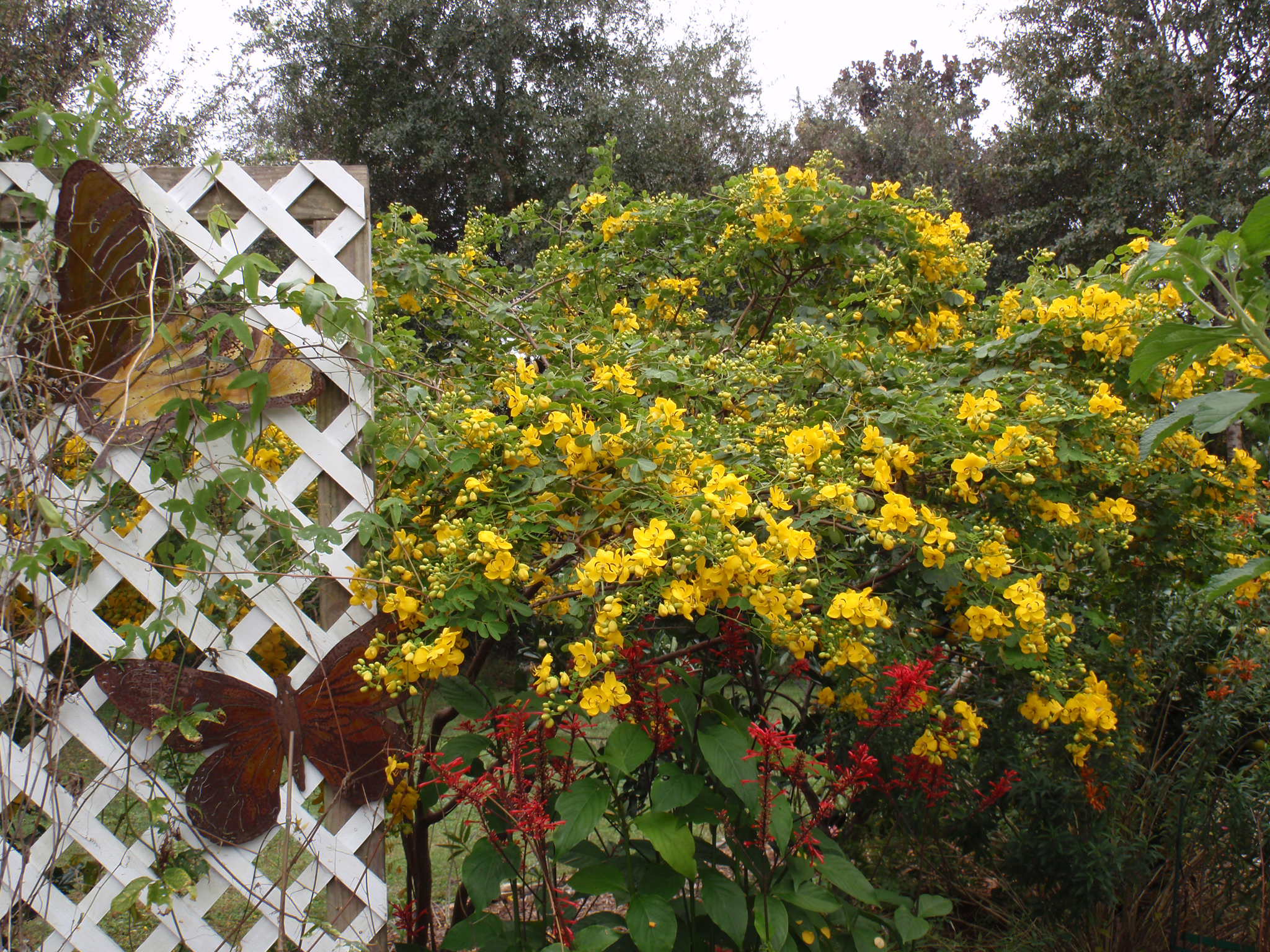
An added benefit of this species of cassia is that it can serve as a host for sulfur butterflies. Blooms will often last until first frost and plants may be injured by freezing temperatures. Homeowners will cut back cold damaged stems and wait for regrowth in the spring. During the growing season, larger plants may need support and summer storms can break some branches. Despite these issues, the fall flower show makes this a highlight in a garden. Learn more about this cassia from the University of Florida IFAS Extension.
by Beth Bolles | Oct 7, 2013
It is now too late for homeowners to apply nitrogen fertilzers to warm season lawns for the year.
Many fertilizers are available in the stores and promotions are everywhere that state that now is the time for lawns to be winterized. Applications of nitrogen after mid September can lead to turf problems next spring. Nitrogen encourages growth of the grass which uses up stored food. As the weather frequently changes throughout the winter months, grasses may use up their food reserves and not have enough carbohydrates to regrow when weather consistently warms next year.
Besides creating unnessary new growth as grasses enter winter dormancy, lawns receive additional stresses when gardeners add nitrogen this late in the season One such issue with a late season application of nitrogen is that it can make the grass more susceptible to large patch fungus. This fungus is active when soil temperatures range between 75 and 65 degrees F. Nitrogen applications encourage lush growth which can increase the incidence of the disease.
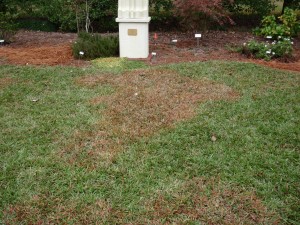
Large patch fungus can be more of a problem on turf following late season nitrogen applications.
For those that feel it necessary to apply some type of fertilizer now, potassium may be applied for the next couple of weeks. Potassium is often sold as a 0-0-60 and the rate is about 1.5 lbs. of the fertilizer per 1,000 square feet of lawn.
Learn much more about lawn fertilization from the University of Florida IFAS Extension.











